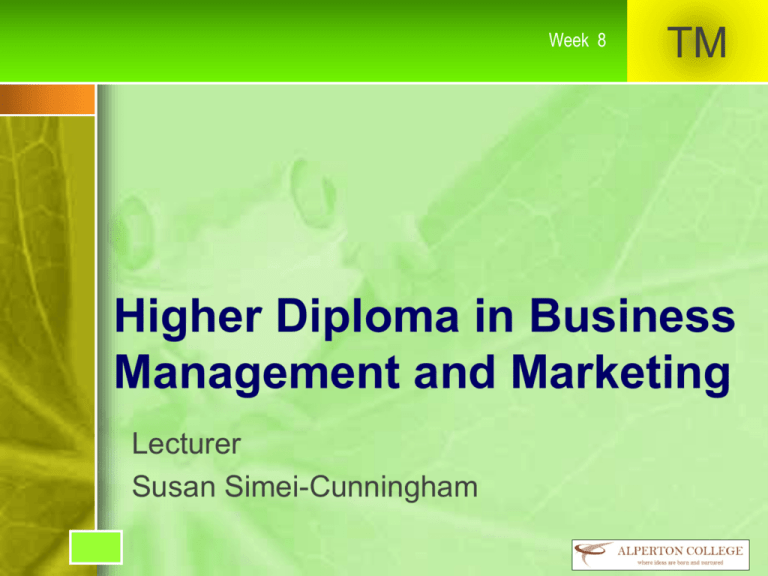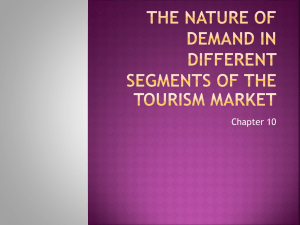Tourism Management
advertisement

Week 8 TM Higher Diploma in Business Management and Marketing Lecturer Susan Simei-Cunningham Week 8 Tourism Management TM Week 8 TM Learning Outcomes By the end of this session, the student should be able to: Explain the role of motivations, needs, expectation and customer behaviours in the tourism industry. Week 8 TM Motivation Theory When we look at consumer motivation theory in tourism, we recognise that it is really important in relation to the decision making process. Week 8 Task - Definitions Find the definitions for the following terms Motivation Needs Demand TM Week 8 TM Task http://www.mcwdn.org/ECONOMICS/NeedWa nt.html Read and do quiz Week 8 TM Market Segmentation It’s important that we recognise that the theories that we will be looking at break the market up into segments based on: Benefits sought from the travel Needs satisfied by the travel Motivations driving the travel Week 8 TM NEEDS BASED MOTIVATION Week 8 TM Needs Shoemaker (1994) claims there is an implicit assumption in all tourist motivation studies, that the consumer will choose the destination or type of holiday or vacation that will best satisfy his/her desires or needs. Week 8 TM Needs BUT Needs-based motivation theories have been criticised in the tourism and other consumer motivation literature because the need may not predict the behaviour (Witt & Wright 1992) Week 8 TM Maslow’s Hierarchy of Needs http://www.youtube.com/watch?v=zIvRITVgyK M Week 8 TM Week 8 TM Maslow Maslow’s need hierarchy has been called an ‘emotional trigger’ that enables marketers to communicate with their target audiences on a personal, meaningful level that goes beyond product benefits (Schrocer 1991). But is said to be too general. Week 8 TM Needs Based Motivation The way in which an individual’s needs may be translated into motivated behaviour is necessary when researching tourist motivation and other such factors must be taken into consideration if the explanation of tourist motivation is to be of use in predicting behaviour. Week 8 TM Task – Group Exercise http://www.docstoc.com/docs/52325381/Maslo ws-Hierarchy-of-Needs-Quiz Week 8 TM VALUES-BASED MOTIVATION Week 8 TM Values-based Motivation There has been considerable research undertaken in relation to the impact of personal values on tourist motivation and consumption behaviour including Travel behaviour, Travel decisions, Vacation activity preferences Vacation motives . Week 8 BENEFITS SOUGHT OR REALISED BASED MOTIVATION TM Week 8 TM Benefits Based Motivation A superior approach to market segmentation with the strength being that it relied on causal factors than descriptive factors and therefore was a good predictor of future consumer behaviour. Week 8 TM Five Types of Benefits Five categories of experiential benefits are generally recognized Psychological, Sociological, Psychophysiological, Economic, Environmental (Driver, Brown, & Peterson 1991). Week 8 TM Exercise – Group Task Get into groups of 5 each take an term, find the definition and then share your definitions. Week 8 EXPECTANCY THEORY TM Week 8 TM This is about the way people’s expectations give motivated behaviour its direction (Witt & Wright) 1992. Week 8 TM Expectancy Model An expectancy model of holiday preference and choice, which incorporates needs, attractiveness (valence) of holiday attributes, Relative preference of different holidays, The influencing factors of knowledge of holiday destination characteristics Limiting factors such as cost expectations; Marketing material such as brochures etc Week 8 TM Video http://www.youtube.com/watch?v=eOvgD80RJ _A Week 8 Summary TM Week 8 TM Three types of applications are identified : Attribute-based (e.g., using a destination’s or tourism services’ attributes or features as the benefits); psychologically-based (e.g. “grouping customers on the basis of the importance they attach to a combination of sensory, rational and emotional benefits expected from the product or service” Lewis 1981, p.43); or a combination of both. Another typology identifies two contrasting operationalisations of benefits emerging in the tourism literature (Tian et al 1996): before the 80s, benefits were almost exclusively defined in terms of visitors’ ratings of desired amenities and activities (e.g., Crompton 1979







